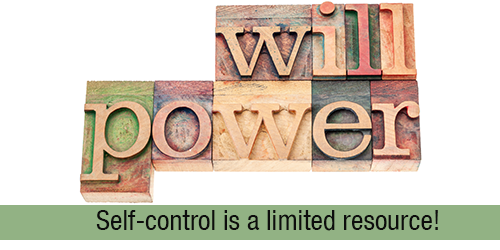Anyone who has tried to stick to a diet, or even a “healthy lifestyle change,” has likely asked themselves at one time or another: Why is self-control so difficult?
Self-control is a limited resource
In a study about self-control, researchers put bowls of cookies and radishes on the table for the participants to snack on while they were waiting for the study to begin. One group was asked to eat radishes but no cookies, whereas the other group was free to eat the cookies. Afterward both groups attempted to solve a puzzle (which unbeknownst to them, was unsolvable). The cookie eaters persisted at trying to solve the puzzle much longer (19 minutes) than the radish eaters (just 8 minutes)!
Essentially, the study showed that using self-control to not eat that cookies made participants less likely (or able) to stick to other challenging tasks successfully. The conclusion is that people can run out of self-control!
In other words, self-control is a limited resource, so you can use it up throughout the day.
That is one reason self-control is difficult
Isn’t it interesting that two seemingly unrelated tasks—resisting chocolate chip cookies and sticking to a difficult task—could be related?

My pre-nondiet days proved that to me again and again. It seemed the more I resisted the foods I loved, the more difficult other aspects of my life seemed to get. I thought I was just tired or irritable (I was), but this study provides another possible explanation. Perhaps “using up” my quota of self-control by dieting didn’t leave as much self-control for doing boring chores or curbing my tongue.
These days, I approach my eating decisions as choices, not a matter of will power. That way, managing food isn’t a matter of using will power and self-control, it’s a matter of being in charge. This graphic compares the differences.
(The first chapter of Eat What You Love, Love What You Eat is called “In Charge, Not in Control.” You can download it here free to further understand the difference.)
If self-control is difficult, be in charge instead!
The key to sustainable changes to your eating, physical activity, and self-care is to learn how to be in charge instead of using will power and self-control. Here are a few steps to get you started.
- All decisions happen in the present moment. That is why mindfulness is so helpful! Mindfulness is simply nonjudgmental awareness of the present moment.
- Whenever you feel like eating, pause to notice what is happening. This Body-Mind-Heart Scan will guide you through a process:
- Notice your physical sensations, such as hunger, thirst, fatigue, tension, pain, and so on.
- Notice your thoughts, like It’s lunch time! I better eat now in case I don’t have time later, or perhaps good-food, bad-food thoughts.
- Notice your feelings
- Once you have gathered this information, you are in charge of making a decision about whether to eat and what to eat!
This is just the beginning of taking charge of your eating.
We explore all these topics in our Eat Mindfully, Live Vibrantly Program. Build a joyful, confident, peaceful relationship with food! Click here to learn more!
I hope to have the opportunity to help YOU learn how to give up on trying to control your eating and learn how to be in  charge instead!
charge instead!
This article has been updated from a previously published version.
If you enjoyed this article, here are three more to help you:
Notice your thoughts about food
What You Resist, Persists: How to Stop Stuffing Down Emotions with Food

